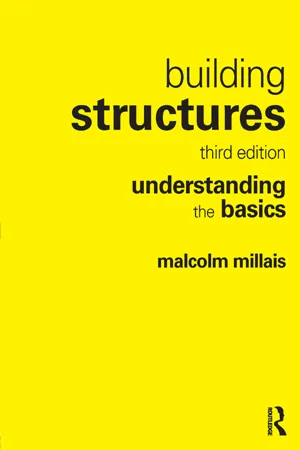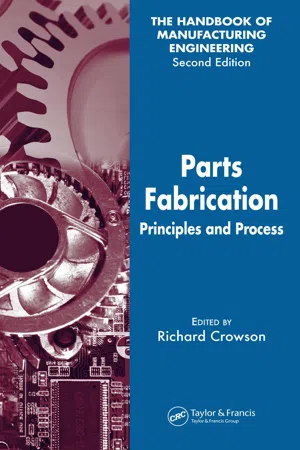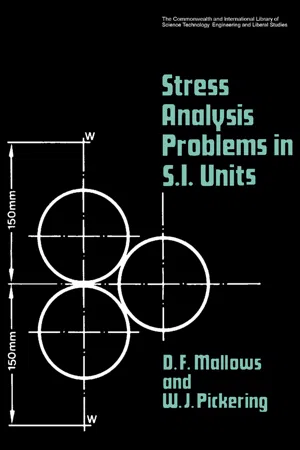Technology & Engineering
Principal Stress
Principal stress refers to the maximum and minimum normal stresses experienced by an object under a given load. These stresses act on planes where the shear stress is zero. Understanding principal stress is crucial in engineering for analyzing material strength and designing structures to withstand varying loads and forces. It helps in predicting potential failure points and ensuring structural integrity.
Written by Perlego with AI-assistance
Related key terms
1 of 5
3 Key excerpts on "Principal Stress"
- eBook - ePub
Building Structures
understanding the basics
- Malcolm Millais(Author)
- 2017(Publication Date)
- Routledge(Publisher)
CHAPTER 4 Advanced concepts of stressIn the last chapter the concept of stress was introduced and it was shown how axial forces, bending moments and shear forces could be related to stress distributions in a structural member. By making simplifying assumptions, the Engineer’s theory in particular, simple stress distributions were obtained. At the end of the chapter the idea of combining stresses was used to show how axial loads and moments are related. Most engineering design is carried out just using these concepts, however, the idea of stress can be used to understand more complicated structural behaviour.This chapter could be omitted on first reading, but the concepts used in this chapter give a deeper understanding of structural behaviour. These concepts can be used to understand more complicated structures than those made of simple beam and column elements, but they also give deeper insights into how simple structures behave.4.1 Principal Stresses in one-dimensional elements
Section 3.8of the last chapter gave one way of combining stresses, but there is another way of combining stresses at points in a structure by using the idea of Principal Stress. The idea of Principal Stress is both conceptually and mathematically more difficult than just adding the axial and bending stresses and keeping the shear stresses separate, but it does give much more information on how a structure acts.To try and understand how a structure acts, slices of the structure have been examined and the idea of stresses has been presented as the effect of forces acting on the face of a slice. The structure does not ‘know’ that the human brain has decided that it is stressed by axial, bending and shear stresses, nor does it ‘think’ that it is made up from a series of slices. When a structural element is loaded by being part of a load path it deforms. Some parts squash and others stretch and internal forces do exist. However, the idea that three types of stress exist on the face of a slice cut at right angles to the length of the element is simplistic. - eBook - PDF
Parts Fabrication
Principles and Process
- Richard Crowson(Author)
- 2006(Publication Date)
- CRC Press(Publisher)
1 Principles of Structural Mechanics Jack M. Walker 1.0 INTRODUCTION TO MECHANICS This chapter is intended for those who may not have an extensive background in structural mechanics, or who have not used some of that knowledge recently and need a refresher. The working manufacturing engineer today is involved in product design, tool design, process selection and development (both parts fabrication and assembly), materials, and many other areas that require an analytical evaluation for proper understanding. In the field of metallurgy, for example, terms such as stiffness, stress, strength, elasticity, and so forth are the language involved—and sometimes we tend to use some of the terms incorrectly. In the fabrication of sheet metal parts, the elongation and yield strength are key elements. In machining, shear may play an important role in understanding cutting principles and selecting the proper cutting tool for a specific material. To understand the discussion of problems in materials and processes, it is essen-tial to know the basic principles of forces in equilibrium. Not all of the elements of today’s complex structural considerations are introduced here. Rather, the intent is to establish a set of definitions and relationships that are needed to understand terms such as tension, shear, compression, and bending . In order to use terms such as stiffness, yield strength, deflection, stress, and strain correctly, the author feels that mathematical relationships offer the only logical approach to definition and under-standing. Care has been taken to avoid the use of advanced mathematics; knowledge of arithmetic and high school algebra is all that is needed. It is the desire of this author to present some simple solutions to everyday structural problems to those individuals with little or no knowledge of mechanics. 1.1 DEFINITIONS OF FORCE AND STRESS 1.1.1 Force Force may be defined as that which exerts pressure, motion, or tension. - eBook - PDF
Stress Analysis Problems in S.I. Units
The Commonwealth and International Library: Mechanical Engineering Division
- D. F. Mallows, W. J. Pickering, N. Hiller(Authors)
- 2013(Publication Date)
- Pergamon(Publisher)
The theories usually studied are listed in Table 10.1. TABLE 10.1 Name Maximum Principal Stress theory Maximum principal strain theory Maximum shear stress theory (Tresca criterion) Shear strain energy theory (von Mises criterion) Yielding occurs when /l = Al or / 3 ~ Jye /i-K/ 2 +/ 3 )=A< or / 3 -K/i+/ 2 )=Ac / l —fz — fyt (/i-A) 2 +(/ 2 -/ 3 ) 2 + (/ 3 -/i) 2 = 2/J Comment Simple but only gives good agreement with experiment for uniaxial loading Another early attempt at a theory, now seldom used Fair agreement with ex-periment and mathe-matically simple Best of the available the-ories for ductile mate-rials In Table 10.1,^, is the yield stress in uniaxial tension andyj, c is the yield stress in uniaxial compression. (h) Composite beams. The general method of analysing beams of two materials was developed for wooden beams reinforced with a metal strip or strips. The method,, with modifications, can be used for reinforced concrete with tension reinforcement, but beyond the ANALYSIS OF STRESS 233 simplest cases it is easier to treat the reinforced concrete beam as a separate problem. General method: making the usual assumption that plane cross-sections before bending remain planes after bending, then the strain e y at y from the neutral axis will be e = 2 . y R' where R is the radius of curvature of the neutral axis. Since stress and strain are related byf/e = E for the uniaxial case then for a beam where there are two materials A and B both arranged to be at y from the neutral axis, then EA EB R Hence it can be shown that one of the materials in the beam, say A, can be removed and replaced by an additional piece of material B of the same depth but of breadth E A /E B times its actual breadth. The stresses in the beam can then be found as if it were a homo-geneous beam of material B. If the stress so found is carried in the real beam by material A, then the true stress will be E A /E B times the stress calculated for the imagined homogeneous beam.
Index pages curate the most relevant extracts from our library of academic textbooks. They’ve been created using an in-house natural language model (NLM), each adding context and meaning to key research topics.


